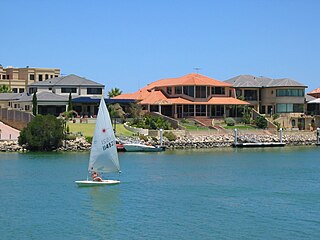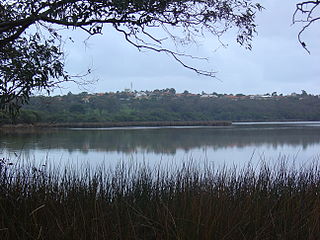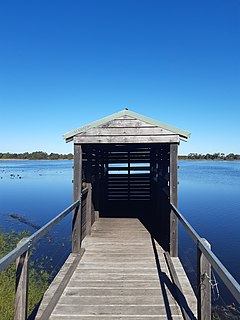Related Research Articles

Neerabup National Park is a national park in the City of Wanneroo in Western Australia, situated approximately 27 kilometres (17 mi) north of Perth.

Yanchep is a national park in Western Australia, 42 kilometres (26 mi) north of Perth adjacent to the locality of the same name Yanchep.

Yagan was an Aboriginal Australian warrior from the Noongar people. He played a key part in early resistance to British colonial settlement and rule in the area surrounding what is now Perth, Western Australia. Yagan was pursued by the local authorities after he killed Erin Entwhistle, a servant of farmer Archibald Butler. It was an act of retaliation after Thomas Smedley, another of Butler's servants, shot at a group of Noongar people stealing potatoes and fowls, killing one of them. The government offered a bounty for Yagan's capture, dead or alive, and a young settler, William Keats, shot and killed him. Yagan's execution figures in Australian history as a symbol of the unjust and sometimes brutal treatment of the indigenous peoples of Australia by colonial settlers. He is considered a hero by the Noongar.

The City of Wanneroo is a local government area with city status in the northern suburbs of Perth, Western Australia. It is centred approximately 25 kilometres (15.5 mi) north of Perth's central business district and forms part of the northern boundary of the Perth metropolitan area. Wangara encompasses the federal divisions of Cowan, Moore and Pearce.
Wembley is a western suburb of Perth, Western Australia, located within the Town of Cambridge. Its postcode is 6014.

Eglinton is a locality in the Western Australian capital city of Perth, approximately 44 kilometres (27 mi) north of Perth's central business district on the Indian Ocean. For the most part, the suburb is covered in native banksia woodland, scrubland and heath typical of the Swan Coastal Plain. However, in recent years, there has been growth in residential estates, with a town centre to be built in the near future. There are also plans for the Joondalup railway line to be extended through the suburb with Eglinton railway station to be located inside Allara estate.

Mindarie is an outer coastal suburb of Perth, Western Australia. It is located 36 kilometres (22 mi) north of Perth's central business district, and forms part of the City of Wanneroo local government area.

Neerabup is a rural locality in Perth, the capital of Western Australia, within the local government area of the City of Wanneroo.

Beeliar is a suburb of Perth, Western Australia, located within the City of Cockburn. The name refers to the Beeliar people, a group of Aboriginal Australians who had land rights over the southern half of Perth's metropolitan area. The suburb contains the Thomsons Lake Nature Reserve.

Lake Monger is a large urban wetland on the Swan Coastal Plain in suburban Perth, Western Australia nestled between the suburbs of Leederville, Wembley and Glendalough.

The Bindjareb, Binjareb, Pindjarup or Pinjareb are an Indigenous Noongar people that occupy part of the South West of Western Australia.

Whadjuk, alternatively Witjari, are a Noongar people of the Western Australian region of the Perth bioregion of the Swan Coastal Plain.

Perth was founded by Captain James Stirling in 1829 as the administrative centre of the Swan River Colony. It gained city status in 1856 and was promoted to the status of a Lord Mayorality in 1929. The city inherited its name due to the influence of Sir George Murray, then Member of Parliament for Perthshire and Secretary of State for War and the Colonies.
The Beeliar Wetlands is a wetland located in the southwest portion of Western Australia. It is made up of two chains of lakes and wetlands that run parallel to the west coast of Western Australia. They are situated on the Swan Coastal Plain between the Darling Escarpment and the Indian Ocean. Beeliar was the name given to the area by the Aboriginal people that lived and hunted in the area.

Lake Joondalup is a medium-sized freshwater lake in Perth, Western Australia. It is in the Perth northern suburbs of Joondalup, Wanneroo, and Edgewater. It is a nature reserve and part of the Yellagonga Regional Park.
This is a timeline of Aboriginal history of Western Australia.

Yellagonga Regional Park is in Perth, Western Australia, in the City of Wanneroo and the City of Joondalup. The park was established in 1989 by the Western Australian government and protects 1,400 hectares of land, including 550 hectares of Wanneroo wetlands – including Lake Joondalup, Beenup Swamp, Walluburnup Swamp and Lake Goollelal.

Beeliar Regional Park is a conservation park approximately 19 kilometres (12 mi) south of the central business district in Perth, Western Australia, located within the Citys of Cockburn, Kwinana and Melville. The regional park is named after the indigenous Beeliar people of the area.
The Wanneroo wetlands are a series of wetlands, swamps and lakes that occur on the Swan Coastal Plain of Perth, Western Australia. They are linked very closely to the Gnangara Mound.
Tourist Drives in Western Australia are routes through areas of scenic or historic significance, designated by route markers with white numbers on a brown shield. Tourist Drives were introduced into Western Australia while Eric Charlton was the state government Minister for Transport in the 1990s. The 28 numbered routes collectively traverse more than 2,000 kilometres (1,200 mi) across the state. In addition to the Tourist Drives, there are unnumbered routes such as the Golden Pipeline Heritage Trail, and local governments may designate and maintain local scenic drives, generally unnamed and unnumbered.
References
- ↑ North Beach Historical Society (1980). Recollections from a shoreline. Artlook (The West Australian). pp. 61–63.
- ↑ Heritage Council of WA (June 1998). "Yaberoo Budjara Heritage Trail" (PDF). p. 3. Archived from the original (PDF) on 20 August 2006. Retrieved 4 January 2007.
- ↑ Daniel, Guy; Cockman, Margaret (February 1979). The Story of Wanneroo. West Australian Newspapers Ltd. p. 3.
- ↑ Brittain, Robert Keith (1990). Yellagonga Regional Park, City of Wanneroo : ethnography position paper for Department of Planning and Urban Development. Kidd and Povey.